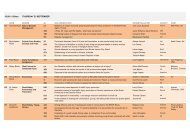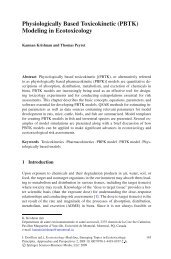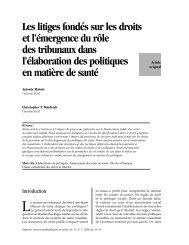Characterization of protective gloves stiffness: Development of a ...
Characterization of protective gloves stiffness: Development of a ...
Characterization of protective gloves stiffness: Development of a ...
You also want an ePaper? Increase the reach of your titles
YUMPU automatically turns print PDFs into web optimized ePapers that Google loves.
1032 L. Harrabi et al. / Safety Science 46 (2008) 1025–1036<br />
measurements because <strong>of</strong> limitations related to the glove thickness and/or design. Except for a few exceptions,<br />
the measured bending rigidity exhibits small standard deviations, indicative <strong>of</strong> the good reproducibility <strong>of</strong> the<br />
results. The data are spread over more than a decade <strong>of</strong> lN m, thus allowing for an easy separation <strong>of</strong> the<br />
glove performance in terms <strong>of</strong> <strong>stiffness</strong>.<br />
The comparison between the measurements performed along the longitudinal and transversal directions <strong>of</strong><br />
the <strong>gloves</strong> shows some varied behaviors. For some <strong>of</strong> the <strong>gloves</strong>, the values <strong>of</strong> bending rigidity in the longitudinal<br />
and transversal directions are identical within the measurement uncertainty. However, for other glove<br />
models, the values measured in the longitudinal and transversal directions may differ by a factor <strong>of</strong> 2 or more.<br />
While differences between the warp and weft directions are expected for anisotropic materials like knit or<br />
woven fabrics and for composites including a textile liner, large discrepancies between the measurements performed<br />
along the glove longitudinal and transversal directions are also observed for <strong>gloves</strong> made <strong>of</strong> pure elastomer,<br />
reaching 50% for example in the case <strong>of</strong> the natural rubber Best HD 55 <strong>gloves</strong>. These sometimes large<br />
differences obtained for longitudinal and transversal bending rigidity translate into major discrepancies<br />
between the glove rankings based on their <strong>stiffness</strong> along the longitudinal and transversal directions, up to<br />
eight places for a total <strong>of</strong> 26.<br />
3.2. The free-deforming multidirectional test method<br />
The 28 selected models <strong>of</strong> <strong>protective</strong> <strong>gloves</strong> were tested with this free-deforming multidirectional method.<br />
For the ten less stiff <strong>gloves</strong>, the maximum force and the total work were obtained (Harrabi et al., 2006). Both<br />
parameters lead to the same ranking <strong>of</strong> the <strong>gloves</strong> on a <strong>stiffness</strong> scale. This can be seen as an indication <strong>of</strong> the<br />
usefulness <strong>of</strong> the work as a parameter for characterizing the material <strong>stiffness</strong> as well as <strong>of</strong> the validity <strong>of</strong> the<br />
technique principles.<br />
The results in terms <strong>of</strong> initial work are provided in Fig. 10 in the form <strong>of</strong> a histogram for the 28 models <strong>of</strong><br />
<strong>gloves</strong>. It can be seen that the data are spread over more than a decade <strong>of</strong> N mm and display a good reproducibility<br />
as shown by the low standard deviation values. A comparison <strong>of</strong> the <strong>stiffness</strong> ranking <strong>of</strong> the ten less<br />
stiff <strong>gloves</strong> based on the maximum force and total work with that based on the initial work shows a good<br />
agreement between the different methods <strong>of</strong> data analysis (Vu-Khanh et al., in press). The slight differences<br />
Work on the first 10-mm glove deformation<br />
(N.mm)<br />
350<br />
300<br />
250<br />
200<br />
150<br />
100<br />
50<br />
0<br />
Class 1<br />
Class 2<br />
Class 3<br />
Class 4<br />
Class 5<br />
Class 6<br />
Ansell Hyflex 11-900<br />
Ansell Canners & Handlers # 392<br />
Ansell GoldKnit Kevlar 70-225<br />
Best Nitri-Solve® 747<br />
Ansell PowerFlex 80-100<br />
Best The Original Nitri-Flex® 4000P<br />
Best Skinny Dip Aramid® 4811<br />
Best Natural Rubber Latex HD® 55<br />
Best KPG® 960<br />
Ansell Hyd Tur 52-547<br />
Best Nitri-Pro® 7000P<br />
Ansell Golden Grab It 16-300<br />
Ansell The Duke 70-982<br />
Ansell Seams-Rite 20-115<br />
Ansell Hycron 27-607<br />
Ansell Grab It Safe 28-362<br />
Best Ultraflex Nitrile® 22-R<br />
Best Cannonball® 803<br />
Best Cannonball® 812M<br />
Ansell Grab It 6-620<br />
Ansell Scorpio 8-352<br />
Ansell Winter Monkey Grip 23-193<br />
Best Insulated Snowman 2950<br />
Ansell Crusader 42-325<br />
Ansell Snorkel 4-412<br />
Best Neo Hyde® 361<br />
Best Neo Grab® 6780-R<br />
Ansell Neox 9-022<br />
Fig. 10. Initial work using the free-deforming multidirectional method.













